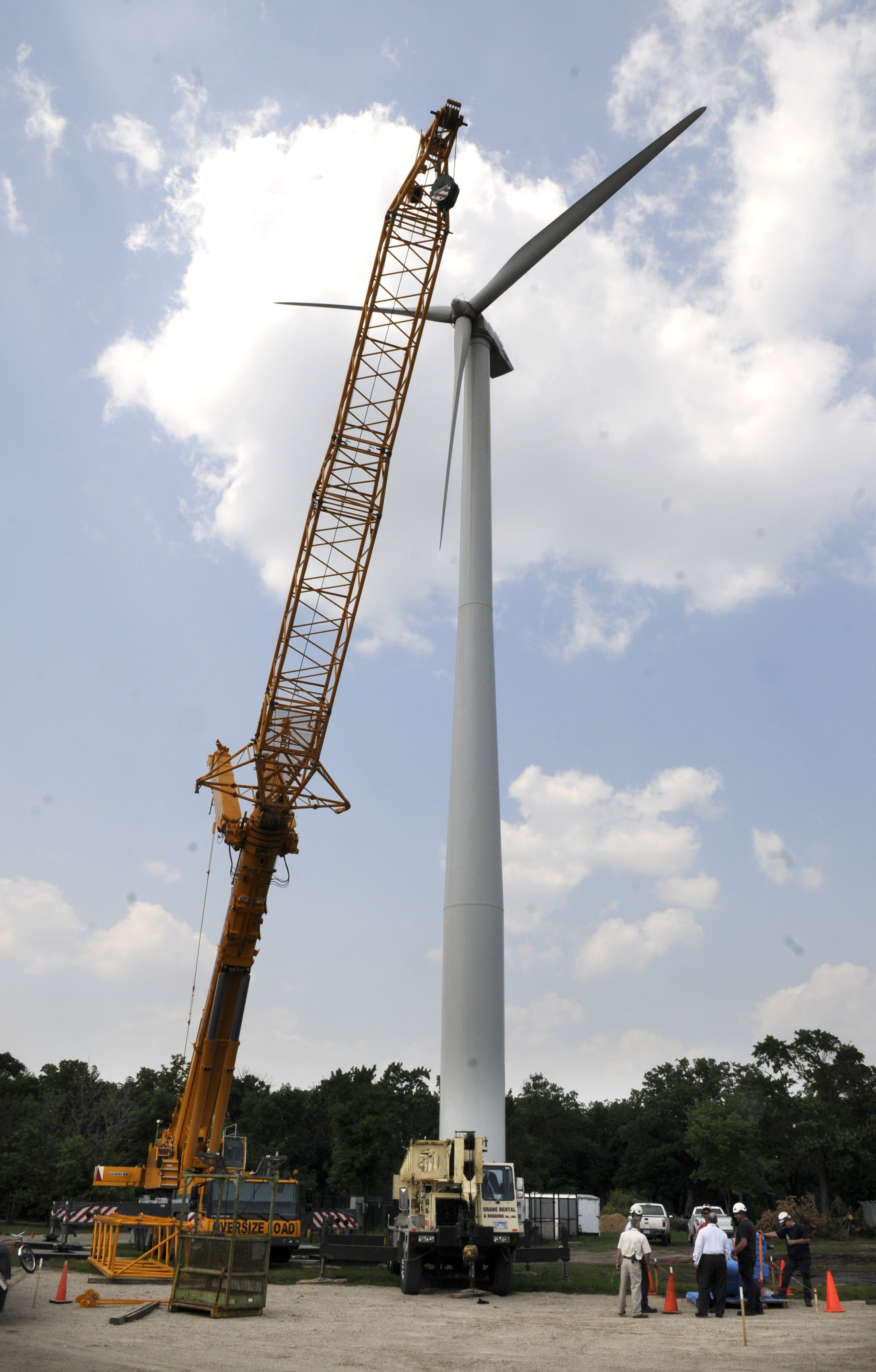![-_20130713.jpg[ID=14883339] ID=14883339](http://www.gannett-cdn.com/-mm-/d0c6787e0b50a815fa5f3708d7cd7602f417c8af/c=0-1713-2400-3761/local/-/media/StCloud/2014/08/30/-20130713.jpg) ST. CLOUD, Minn. -- Visions of a national wind energy bonanza have been a costly mirage for the Department of Veterans Affairs, even after five years of work and more than $3.7 million spent.
ST. CLOUD, Minn. -- Visions of a national wind energy bonanza have been a costly mirage for the Department of Veterans Affairs, even after five years of work and more than $3.7 million spent.
A St. Cloud Times investigation found the department has little to show for its coast-to-coast attempt at wind energy development.
Starting in 2009, the VA system studied 14 sites across the U.S. for wind energy projects. Four sites were selected, one of which was the St. Cloud VA Health Care System.
Five years later, just one of those sites — a veterans cemetery in Massachusetts — has a functioning wind turbine.
Efforts to build wind energy systems to power VA facilities in St. Cloud, Utah and New York fell short for various reasons: mechanical problems with a wind turbine, poor site selection and, according to an engineer who worked on one of the projects, a turbine manufacturer that went out of business.
![<data>VA turbine</data>[ID=14889853] ID=14889853](https://presto-kare.gannettdigital.com/Portals/_default/Skins/PrestoLegacy/CommonCss/images/embed.jpg) VA officials gave individual reasons for why each project faltered. What's still unclear is if broader issues with the VA wind effort contributed to so much going wrong in so many places — all while the U.S. wind-power industry was experiencing historic success.
VA officials gave individual reasons for why each project faltered. What's still unclear is if broader issues with the VA wind effort contributed to so much going wrong in so many places — all while the U.S. wind-power industry was experiencing historic success.
In the meantime, U.S. taxpayers are left in the lurch. Much of the more than $3.7 million spent, including the funds for the St. Cloud turbine, came from the 2009 federal stimulus act.
The VA system already is smarting from months of bad publicity. National outrage followed reports that veterans may have died waiting for care at VA medical facilities, while audits found a pattern of fraudulent scheduling practices.
Steve Ellis is vice president of Taxpayers for Common Sense, a national nonpartisan watchdog group. Ellis says the wind debacle is another example of an agency struggling to show it's an effective steward of public funds — not to mention public trust.
"The VA isn't exactly being held up as a paragon of administrative excellence," Ellis said. "This is an agency that's had troubles over the years.
"It's not that surprising that if they fail at their primary mission, something secondary like generating energy from wind projects, they're going to fail at that as well."
How it started
The seeds for the VA's troubled foray into wind energy development were sown in 2009 and 2010, shortly after passage of the federal stimulus act.
About $330,000 from the act was used to study 14 sites to determine if they'd be feasible locations for wind energy systems. The sites were in 13 states, including VA medical facilities and national veterans cemeteries.
It was part of a broader push under President Barack Obama's administration to boost renewable-energy use by the VA and other federal agencies. The VA says it spent more than $300 million on renewable energy projects from 2009 through mid-2011.
Wind projects were just a small part of the picture. Most projects were solar or geothermal energy or sustainable building certifications.
The renewable-energy projects were meant to help VA meet a goal of drawing 15 percent of its power from renewable sources by 2013. A subsequent order from Obama, issued in late 2013, raised the bar to 20 percent renewable energy use for all federal agencies by 2020.
After the wind energy feasibility studies were conducted, VA officials picked four sites for wind energy projects: VA health care centers in St. Cloud, Manhattan and Salt Lake City, and a national veterans cemetery in Bourne, Massachusetts.
One of those sites, Manhattan, wasn't among the 14 sites studied for feasibility, according to a list supplied by national VA officials. They didn't respond to an inquiry last week about whether the Manhattan site received any study for feasibility before the project began.
VA officials predicted the wind projects would help VA facilities reduce energy bills while creating environmental benefits.
"Ensuring the sustainability of our facilities across the country allows us to use energy-efficient buildings to accomplish our primary mission — serving veterans," then-Secretary of Veterans Affairs Eric Shinseki said in a 2009 news release announcing the St. Cloud wind project.
An unexpected turn
The Big Apple was one of the places where the VA's wind development efforts were set to make a splash.
But the project there took an unexpected turn. A wind energy system wouldn't work at its initial location, the Manhattan Campus of the NY Harbor VA Healthcare System.
VA officials then pivoted to a plan to install the system at the James J. Peters VA Medical Center in the Bronx. But it's not yet clear if the project will materialize there, either.
It all started when VA officials in 2010 announced a pair of wind projects: a five-turbine, 20-kilowatt wind energy system at the Manhattan VA campus and a 10-kilowatt system at the VA Salt Lake City Health Care System.
The plan for the Manhattan campus went by the wayside with the discovery of "unforeseen structural issues for the roof where the wind turbine was planned to be installed," according to the national VA public affairs office.
By then, $371,544 had been spent on the project, including the purchase of five wind turbines.
VA officials decided last summer to install those turbines instead at the Bronx facility.
About $94,482 had been spent for project design at the Bronx site as of June, according to the national VA public affairs office. The project was in the design phase at that point.
VA officials said Friday they completed design work on the project and published a request for proposals for it. But they didn't receive any feasible proposals.
The department "is evaluating potential courses of action at this time," according to a statement issued Friday.
Meanwhile, the Salt Lake City project was running into similar problems.
The project was canceled in 2013 after the discovery of "unforeseen structural issues for the roof where the wind turbine was planned to be installed," according to the national VA public affairs office. About $26,430 was spent on that project before it was scuttled.
But an engineer at the Salt Lake City facility tells a different story for why the project faltered. Leon Jones, who worked on the project, says the turbine manufacturer for the project, Tangarie Alternative Power, shuttered its factory in 2012.
After that, Jones said he and other engineers in Salt Lake City told VA brass it was time to pull the plug.
"We didn't feel it was worth the effort" to find another manufacturer, given the small amount of energy savings anticipated from the project, Jones said.
Of the four wind projects launched by the VA system, only the Massachusetts National Cemetery turbine stands today as a wind project done right.
The 50-kilowatt machine, dedicated in 2011, was anticipated to generate as much as 95 percent of the energy needed to power the Bourne cemetery.
The turbine is outperforming projections. It produced more than twice as much power as the VA system expected, according to the VA's national public affairs office. About $624,524 was spent on the project.
A showpiece
A hulking 600-kilowatt turbine at the St. Cloud VA Health Care System was intended to be the showpiece of VA wind development efforts.
At a cost of more than $2.2 million, it accounts for more than half of the total spent nationwide on the VA wind initiative.
Instead, the turbine, manufactured by India-based Elecon Turbowinds, has been inoperable for the last two years. A litany of hydraulic and electrical repairs have been conducted to no avail.
St. Cloud VA spokesman Barry Venable said earlier this month the agency continues to talk with project contractors about "achieving the value for the government per the specifications outlined in the contract." The lead contractor on the project was Massachusetts-based J.K. Scanlan Co.
Venable wouldn't say when, if ever, the turbine will generate power. VA already has paid out about 99 percent of the $2.3 million contract.
"I wouldn't care to characterize things in terms of a timeline," Venable said. "In terms of what we do here every day, we're more focused on taking care of veterans.
"Not to say the turbine's not receiving appropriate emphasis. It is. But it's an object out there, of concern."
Venable wouldn't say if the VA is pursuing litigation in connection with the project.
"It would be inappropriate from both parties' perspectives to comment on your question," he said. "If it were to come to that, it would be the lawyers speaking to that, not me."
Competing tensions
Ellis, from the nonpartisan watchdog group, says the St. Cloud project shows how federal agencies had to balance competing considerations for projects funded by the $831 billion stimulus act.
Funds for stimulus projects needed to be disbursed swiftly to deliver the economic jolt that was the act's purpose. At the same time, accountability for those funds needed to be assured.
With the St. Cloud project, Ellis says it's the VA's job to assure accountability.
"If they bought a lemon, they need to demand that they make some lemonade," Ellis said.
Meanwhile, local wind experts such as Charles Grell wonder what went wrong with the VA wind energy push.
Grell owns St. Cloud-based Gone 2 Green Wind & Solar, which installs small wind and solar energy systems. He says the VA ignored or didn't seek input from Minnesota wind firms on the St. Cloud project. He also says the turbine's manufacturer lacks an established track record in the U.S.
The turbine's motionless blades tower over St. Cloud's west side and nearby Minnesota Highway 15. Grell says it's like a giant advertisement for the perils of wind development. But successful wind projects aren't hard to find in Minnesota. They've been completed throughout the U.S. in recent years — just not on the VA's watch, with one exception.
"All you're doing is hurting the public's perspective on green energy that does work," Grell said.
HOW WE GOT THE STORY
The St. Cloud Times investigation of the Department of Veterans Affairs' wind energy development began with a story about the development at the St. Cloud VA Health Care System.
After learning about the VA wind projects outside of St. Cloud, it became clear there was a broader story to tell.
Most of the information in the story came from inquiries or Freedom of Information Act requests to VA officials. Some came from VA news releases and other official documents. And some came from interviews with VA employees or other experts.
Visit www.green.va.gov to learn about the Department of Veterans Affairs' efforts to generate green energy to power its facilities. The site includes a map of VA green-energy projects nationwide.


